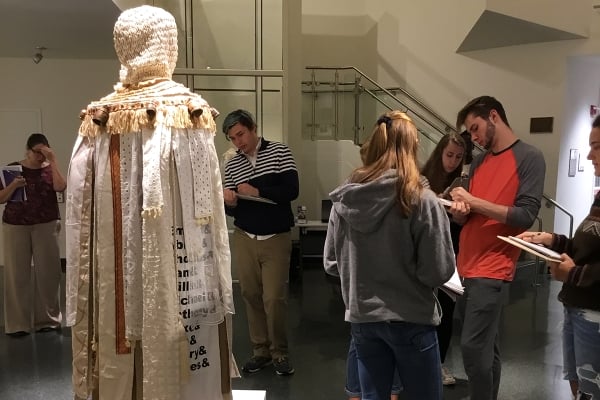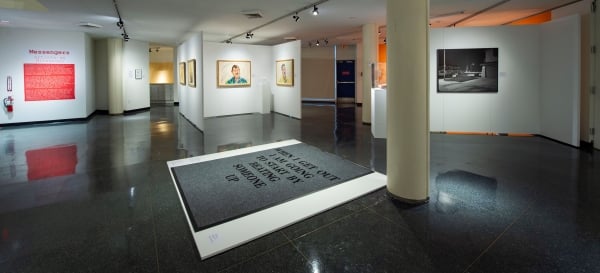When the University of New Hampshire closed its on-campus art museum last month amid a $14 million budget shortfall, the decision drew predictable criticism from students, alumni and donors.
But the closure also caught the attention of academic museum professionals who believe museums are crucial to advancing the mission of higher education institutions, especially research-focused public flagships such as UNH.
“Academic art museums have become increasingly adept at strengthening curricula across campus, from art and art history to languages and literature, mathematics and sciences, business, and more,” the board of the Association of Academic Museums & Galleries (AAMG) wrote in a letter last week to James Dean Jr., president of UNH, urging him to reconsider the closure.
“Alas, closing a museum will not save a university, as great universities have great museums.”

Dean has said declining enrollment— the main campus had 13,860 students in 2022, down from 15,479 in 2017—and inflated operating costs led to the multimillion-dollar deficit that resulted in eliminating 75 total jobs at the university, which included the art museum’s director and the three other staff members.
As the AAMG outlined in its letter to Dean, the UNH Museum of Art’s value extended beyond enhancing the curriculum, offering internships and expanding students’ cultural awareness. It also provided a public space that connected the campus with the surrounding community of Durham through educational programming partnerships for K-12 students, senior citizens and medical centers in addition to enticing “visitors who may be new to the university and who may become museum and university donors.”
The museum’s abrupt closure, however, demonstrates the potential vulnerability of academic museums dotting a national higher education landscape marked by enrollment declines that are expected to worsen in coming years.
The Dean’s Decision
Kristina Durocher, who directed UNH’s art museum from 2011 until its closure, said she’d been concerned about the oversight of the museum for years. The museum was under the purview of the College of Liberal Arts at UNH, which meant that if a directive for budget cuts came, the dean of the college would have to weigh the costs of running the museum along with keeping academic programs afloat.
That’s what the decision to close eventually came down to for Michele Dillon, dean of the College of Liberal Arts, who was tasked with cutting roughly $1.5 million from the college’s “already very lean” budget.
She watched as other universities—especially West Virginia University—slashed their liberal arts programs and hoped a similar decision might not befall New Hampshire’s public flagship R-1 institution.
“My commitment was to bolster all of our academic programs. That didn’t leave much else to look at,” Dillon said, adding that her decision to eliminate the museum was difficult and not reflective of her perception of its value. “When you’re confronted with a constrained budget environment, these are the sort of choices that academic leaders increasingly and sadly have to make.”
But the vast majority of R-1 institutions have museums, and colleges and universities house more than 1,600 museums across the United States.
Durocher said the museum she ran also furthered UNH’s mission as a research-intensive institution by making “the research of the university visible to the public.” One such example was the 2021 exhibition “Wendy Klemperer: Artist at Sea,” which displayed artistic observations of a project undertaken by the UNH Center for Acoustics Research and Education.
In 2019, Dillon approved the museum’s strategic plan, which included a goal to bring the museum under the provost’s office instead of the College of Liberals Arts, which is in line with the AAMG’s best practices.
“She was supportive because she recognized the Museum of Art served more than just the faculty and students in the college,” said Durocher, who is also president of AAMG but was not involved in the board’s letter to the UNH president on Feb. 5. “We really served the entire teaching mission of the university.”
But the plan to move authority over the museum to the university provost became secondary to updating the physical space, which first opened as an art gallery in the 1960s before becoming a full-fledged museum in 2010. It houses an extensive collection of paintings, photographs and prints from artists such as Andy Warhol, Hyman Bloom and Max Ernst and has hosted numerous exhibitions featuring work from local, regional and nationally known artists.

‘Really Surprised’
While Durocher was aware of UNH’s dim budget picture, she was still making plans for the museum right up until it closed.
Last summer, the museum solidified plans to install a new HVAC system. That would have been one of the final steps of preparing it to apply for accreditation, which can elevate prestige and expand access to outside funding sources. But the project was postponed days before construction was slated to begin in early December. Six weeks later, the museum closed entirely.
“We were really surprised,” Durocher said. “The dean put together recommendations that had to be approved by the people reviewing the budget. That’s not to say the same outcome couldn’t have happened” if it were under the provost.
According to Durocher, roughly 85 percent of the museum’s estimated $600,000 annual operating budget came from the university, and the remainder came from a mix of restricted endowed funds, earned income and donations.
Durocher said she understands the university’s tough financial predicament led to the museum’s closure, but nonetheless she would have appreciated more transparency from administrators, during the strategic planning process years ago, about the potential threats those deficits posed to the museum.
“Having financial sustainability be part of that plan would have helped. It would have given me and my board a clear directive and some objectives that we could have met,” she said. “I’ve heard from alumni and donors … They’re very angry and shocked about this decision. They’re appalled that the university would close its museum.”
‘Museums Are Forever’?
Marilyn Hoffman, a donor and member of the UNH museum’s board of advisers, said she supported it because it’s an asset to the campus and the community that she doesn’t want to lose.
“It’s a place that meets one of the university’s goals about being welcoming to diverse groups of people,” she said, recalling that many of the exhibits have focused on themes of social justice. “Museums are forever. Collections are held in trust for future generations. Closing it is not something that should have happened. We feel they made a mistake and that we can get enough support to make this a win-win situation so the museum does not have to end.”
Hoffman believes the museum has the donor base to raise enough private funds to stay open for another year and figure out a sustainable, long-term plan in the meantime. And with President Dean set to retire this summer and New Hampshire governor Chris Sununu not seeking re-election in 2024, she’s hopeful “things could change in the future if we could just create a bridge to the future.”
She and other supporters of the museum met with the provost Friday to discuss that possibility, but she said no decisions have yet been made.
Asking the provost to assume oversight of the museum isn’t part of Hoffman’s immediate plans. “That’s a long-range issue,” she said. “Right now, we’re just trying to keep the museum from closing forever.”
Benjamin Cariens, chair of the university’s art and art history department, wasn’t surprised by the announcement of the closure and said he’d long had concerns about the College of Liberal Arts overseeing the museum instead of the provost.
“When the dean is charged with trying to make up a significant financial gap, things like the museum are always going to be more vulnerable,” he said. “It started to feel like there was a college commitment to the arts, but perhaps not a university commitment.
“We needed to have a more adequate definition of how a museum would function for us … How one defines the needs and desires for the kinds of programming within those spaces can impact an institution’s ability to commit.”
Unlike past high-profile examples of universities—such as Brandeis University and Valparaiso University—attempting to sell pieces from their collections, UNH has no plans to sell its art. Cariens said if the museum were to reopen, that process would have to be guided by discussion about how it serves UNH’s broader mission and “could only be sustainable if it falls under the provost and not the college.”
For now, the tentative plan is for the museum space to stay open as a smaller gallery to exhibit student projects and for the art and art history department to take on the responsibility of maintaining the collection until a long-term collections-management plan is established.
Jill Hartz, past president of AAMG and former director of the Jordan Schnitzer Museum of Art at the University of Oregon, said putting faculty in charge of the collection isn’t recommended and puts the artwork in jeopardy.
“They’re not trained to be gallery and museum people,” she said.
Hartz, who authored the AAMG’s letter to President Dean, also outlined the risks and complications of putting an academic museum under the oversight of a dean instead of a provost.
“The experience of the AAMG board and other members of our field is that when a museum’s unique importance is recognized at the highest levels both within the academy and the larger community, efforts are made, through fundraising and reallocations, to maintain the museum,” she wrote in the letter.
Other Museums Under Deans
The UNH Museum of Art isn’t the only academic museum that’s operated under an ill-advised structure.
As of 2022, 32 percent of academic museum directors reported to an academic division dean, 29 percent reported to the provost, 11 percent reported to a department chair and 7 percent reported to the president, according to an AAMG survey of nearly 200 academic museums.
Katie Lee-Koven, executive director and chief curator of the Nora Eccles Harrison Museum of Art at Utah State University, said when she first took the helm at the museum a decade ago, it reported to the college of the arts. But she made the case to university administrators that the museum serves “faculty and students across the entire campus, and we serve our community as well.” Her museum then came under the oversight of the provost before moving under the president’s office. She said both of those changes made her feel more secure about the museum’s future compared to when it was under the arts college.
“It’s not an academic museum’s job to teach administrators about the value of something that is part of their campus,” Lee-Koven said. “And yet, it is not uncommon for us as museum directors to find ourselves in a role of regularly reminding and educating our parent institutions about what we do, how we do it and how we’re of value to them.”
What’s more, most accreditors of colleges and universities don’t assess how academic museums support an institution’s mission, which “makes us potentially more vulnerable,” she said.

